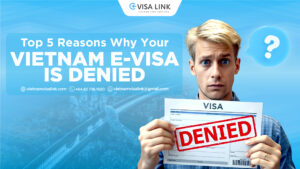Applying for a Vietnam e-visa is a convenient and efficient way to obtain entry into the country. However, despite the ease of the process, some applications get denied. Understanding the common reasons for rejection can help you avoid these mistakes and successfully secure your e-visa. Here are the top five reasons why your Vietnam e-visa might be denied and how you can address these issues.
1. Incorrect or Inconsistent Information
One of the most common reasons for e-visa denial is providing incorrect or inconsistent information in your application. Errors such as typos in your name, passport number, or date of birth can lead to rejection.
How to Fix It:
Double-check all the information you enter before submitting your application. Ensure that every detail matches exactly as it appears on your passport. If your application is denied due to incorrect information, you’ll need to reapply with the correct details. It’s crucial to be meticulous in filling out the form to avoid unnecessary delays.
2. Invalid Passport
Your passport must be valid for at least six months from your intended entry date into Vietnam. If your passport does not meet this requirement, your e-visa application will be denied.
How to Fix It:
Before applying, ensure your passport is valid for more than six months beyond your planned entry date. If your passport is nearing its expiry date, renew it before you apply for the e-visa. A valid passport is a mandatory requirement for the approval of your visa application.
3. Failing to upload qualified documents (portrait photo and passport bio page)
Your e-visa application requires a digital photo, and failure to meet the specific photo requirements is a common reason for rejection. Issues such as improper size, poor lighting, or an unsuitable background can result in denial.
How to Fix It:
Refer to the guidelines provided during the e-visa application process to ensure your photo meets the necessary specifications. The photo should be recent, clear, and have a plain background. If your application is denied because of the photo, you can reapply with a new one that adheres to the standards.
4. Applying for the Wrong Visa Type
Each visa type has specific requirements depending on the purpose of your trip (tourist, business, etc.). Applying for the wrong visa type could result in rejection.
How to Fix It:
Before applying, make sure you select the correct visa type that matches your intended purpose of travel to Vietnam. If unsure, consult the Vietnam Visa Link team or review the official guidelines to find the appropriate visa category.
5. Your Vietnam E-Visa Is Declined as You Are Still Residing in Vietnam
Your application will likely be rejected if you are currently in Vietnam and attempt to apply for an e-visa from within the country, as the Vietnam e-visa is intended for people entering from outside the country.
How to Fix It:
To avoid rejection, ensure you apply for the e-visa while outside Vietnam. If you’re already in Vietnam, you will need to apply for an appropriate visa extension or exit the country before applying for a new visa.
Conclusion
While a denied e-visa can be frustrating, being aware of the common reasons for rejection can help you avoid these issues and increase your chances of obtaining your visa. Always double-check your application for accuracy, ensure your passport meets the validity requirements, and follow photo guidelines closely, so you can navigate the e-visa application process with confidence.
For personalized assistance and expert advice on obtaining your Vietnam visa, contact Vietnam Visa Link. We’re here to guide you every step of the way, ensuring a smooth and hassle-free visa application experience.


